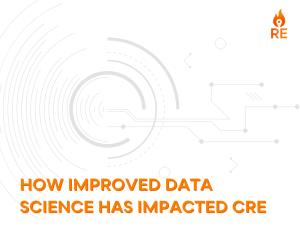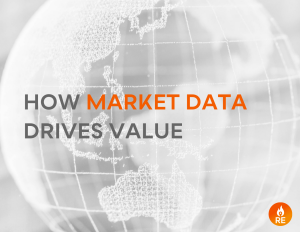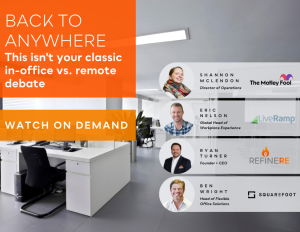Feature
7 Tips for Choosing a Workplace Analytics Software
Where should your team work?
These days, that’s a loaded question. But no matter how you decide to work, you’re likely still sitting on a little (or a lot) of office space.
One of the first steps in deciding your workplace strategy is knowing how your office space is being used, because we’re willing to bet it’s changed since the spread of the pandemic.
So how will you decide what your return to work will look like given the space you already occupy? How will you gain insight on how your space is being used in order to optimize your workplace spend?
Many leading organizations are employing workplace utilization and analytics software.
What is Workplace Analytics Software?
Put simply, a workplace analytics software presents data and analytics on space usage to gauge metrics related to how and when employees are using the office, the effectiveness and popularity of meeting or conference rooms, space density, workforce mobility, usage patterns, and collaboration.
How Workplace Analytics Works
Companies can gather data on workplace utilization in a number of ways. A few examples include the following:
Sensors
- PIR Sensor: A PIR sensor, or passive infrared sensor, uses heat and movement to gather utilization data. PIR sensors are ideal if you want to measure room occupancy. The catch? If your office is open concept, a PIR sensor might not be your best bet. PIR sensors work best in contained rooms rather than open spaces.
- Door Sensor: If you guessed that door sensors measure movement in and out of doors, you’d be correct. Door sensors can be limited in their effectiveness, as they can be deployed only in spaces with a single entry/exit point.
- Vision Sensor: Imagine a camera capturing movement around the office. That footage is then run through a layer of technology that uses artificial intelligence, or AI, to translate the video footage into utilization data points. Vision sensors tend to be pretty accurate, and they work better in open spaces than PIR or door sensors.
Badges
Most corporate employees are familiar with the badging system – swiping or scanning in to enter and/or exit the building. Badges can detect when employees arrive and leave but can be slightly inaccurate if multiple people go in or out at once using a single scan. If badges are placed at floor, hall, or meeting room entries, they can be used for slightly more granular data.
Beacon/BLE
The Bluetooth enabled beacon is perhaps the most complex of these data-gathering methods to understand. To boil it down, a Bluetooth-enabled beacon would be installed in an office, and employees would download an app that coordinates with the installed device. The employees’ installation of the app would allow for the beacon to gather data on metrics like mobility and density. Some organizations are using BLE in an attempt prevent the spread of COVID-19 using contact tracing.
Collaboration Tools
Workplace collaboration tools like Slack and Zoom can actually prove useful in data collection. Employers can use platforms like these in order to gain insights on collaboration and productivity. Office and conference room booking systems can also provide helpful insight into collaboration.
After the collection of workforce data using any combination of data gathering methods mentioned above, the real work begins. You’ve got a bunch of data points floating around – now what? You have to organize, visualize, and analyze it in such a way that it can provide actionable insights to your workplace, real estate, and facilities teams.
That’s where a Workplace Utilization Analytics solution comes in.
Ultimately, Workplace Utilization Software is comprised of 2 parts: the sensors, badges, or other software (we’ll call it “hardware” for the sake of this blog) you’re using to collect data points and the analytics platform (the software) you’re using to view the data in a way that makes visual sense and can help you gain actionable insights. So your 2 components are the hardware and the software, and together, the combo will be your best friend in making back-to-office decisions.
Catch up on the latest from RefineRE:
Questions you can answer with Workplace Analytics Software
You might be wondering where this software solution fits into your overall strategy. You might be surprised the questions you can answer in a few clicks using this type of business intelligence tool. Questions like–
1. What does our actual office utilization look like on any given day/week/month?
2. Is the size of our office footprint appropriate considering the way and frequency with which our employees are using the space?
Did you know that on average, 40% of office space is empty on any given day?
3. Given what we know about the way employees use space to work and collaborate, how can we transfer that knowledge to any new office build outs?
4. Are there any business units that stand out in terms of the way and frequency with which they use office space? Maybe Marketing spends 75% of their time in collaboration spaces while Finance spends 95% of their time at a desk.
7 Considerations for Choosing a Workplace Analytics Software
1. Type of Occupancy Sensors
- Do you already have some sensors in place?
- Does the software I’m looking at integrate with the type(s) of sensors we have or are planning to implement?
2. What are you looking to accomplish with this endeavor?
- Are you trying to reduce OpEx costs, implement contact tracing for preventing the spread of COVID-19, take a look at downsizing your footprint, etc.
- Which sensor and analytics platform will deliver the analytics needed to answer your team’s questions?
3. Granularity
What level of granularity are you looking for? If you simply need to know who’s in the building at what time, you might not need all the bells and whistles. However, if you’re planning to redesign your workspaces and implement workplace policies (in-office vs. WFH or hybrid), you might need to go deeper to get a better understanding of how people are using the space and collaborating with team members and other departments. This applies to the type of data you’re collecting and also the analytics software you employ – you’ll need to choose solutions that fit the specificity you’re looking for.
4. Data agnostic solution
When implementing Workplace Analytics Software, finding one that’s data agnostic is ideal. All this really means is that the software can accept data from any source and isn’t limited to a certain type of sensor or badge. Throughout your workplace journey, you might find that a different sensor type fits your needs better or that you’d like to use Slack data to study productivity, for example. You don’t want to have to go through the process of finding a new software or uploading your data after you’ve already done it once.
5. Total Cost of Occupancy
Like it or not, cost will always play a large role in real estate, facilities, and workplace strategies. It’s important to find a workplace analytics software that presents information in the context of total cost of occupancy. What percentage of rent are you paying for those 70% of employees who haven’t been to the office in over a year? These are the metrics we need to get to.
6. Security & Privacy
What are your organization’s security and privacy policies when it comes to collecting employee data? Some companies will have to go to great lengths to protect employee information due to privacy concerns ¬– especially those based in the EU who must comply to GDPR rules. Both from a hardware and software standpoint, you’ll need to cover your bases to make sure you’re in compliance with organizational rules.
7. Speed to solution
This isn’t a “wait and see” type of thing – you’re under a lot of pressure to make the right choice, and fast. If your decision-making window is tight, you’ll have to consider the type of hardware and software that can be deployed quickly and with minimal heavy lifting on your end.
If you’re looking to implement a solution sooner rather than later, consider employing RefineRE’s Data Foundations Team. RefineRE’s data analysts take care of the heavy lifting and deliver value within 2 weeks. Schedule a 15-minute consultation to identify your biggest back-to-office challenges and explore automated solutions to optimize your strategy.
Catch up on the latest from RefineRE:
Schedule a consultation with RefineRE
Here's what you can expect:
- ‣ A 15-minute call
- ‣ Identify your biggest challenges
- ‣ Explore automated solutions to optimize your strategy





